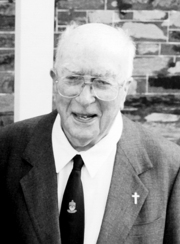
| Date of Birth: | 08/08/1915 |
|---|---|
| Date of Death: | 18/03/2002 |
| Date of Ordination: | 27/07/1941 |
Mgr Thomas Horgan
|
Biography:
Family foundations Thomas Erwin Horgan was born on August 8, 1915 at Mintaro in the mid north of SA. In 1918 the family moved to Adelaide. Tom attended the Dominican school at Glenelg and later he boarded at Rostrevor College. In 1934 he commenced his studies for the priesthood at Corpus Christi College, Werribee, Victoria and then at Propaganda College in Rome. Thomas Erwin Horgan was ordained to the priesthood for the Archdiocese of Adelaide on July 27, 1941, the day on which the foundation stone for St Francis Xavier Seminary at Rostrevor was laid. From 1947 to 1951 Fr Tom was to hold the position of philosophy lecturer at the seminary. To list the parishes in which Fr Tom served as assistant or parish priest, Adelaide, Mt Gambier, Colonel Light Gardens, St Marys, Thebarton, Victor Harbor, Glenelg, Semaphore is to tell only a small part of the story. When appointed as Vicar General in March 1975 he assumed the title of Monsignor, a title he wore lightly. He disliked being addressed as Mons. He said it made him feel like a World War I battle. It was as Vicar General that he was more than ever solicitous for his fellow priests, who were grateful for his care and concern. The thousands of people whose lives he touched in all these areas of ministry remember him as a gentle dedicated and compassionate priest who was there for them at times of illness and mourning as well as the joyful celebrations of baptisms, first communions and marriages. The centrality of the Eucharist in his daily life was clear to all. He was also esteemed as a raconteur par excellence and a man of very dry wit. As a devotee of P. G. Wodehouse and the world of Jeeves, his eloquent use of the English language was unconsciously Wodehousean in its style. Indeed his stories were peppered with whimsical characters of the ilk of Wodehouse's Bertie Wooster and his companions. As a result of his student days at Propaganda College in Rome he had priest friends across Australia and on other continents. Until the end of his days a simple incident in daily life would trigger in Father Tom's memory a tale of Biffy Gilhooley (or some other character with an equally improbable name) who had been part of Fr Tom's journey and who had earned his place in history through a witticism, faux pas or malapropism. Like the householder of the scriptures he would constantly bring forth from the storehouse of his memory treasures old and new. Perhaps the apogee of his oratorical powers was his speech of welcome on behalf of the clergy when Archbishop Gleeson assumed the role of Archbishop of Adelaide in 1971. In a droll mixture of prose, poetry, prophecy, puns, persiflage and profundity he entertained his audience with his belief that the number seven was significant in the life of Archbishop Gleeson. (Not only did the name Gleeson have seven letters, his predecessor Archbishop Beovich was similarly endowed.) The hearers were also told that the yet unannounced new Bishop would also have a surname that would be of seven letters. Bishop Kennedy was to fulfill that prediction. Many other examples of septenary influence in the Archbishop's life were given. The speaker also went on to say that he had recently been given advice by his golfing instructor that could be of value to the Archbishop (and all Bishops?): "Let the club do the work." Wry self-deprecations Many of Fr Tom's yarns or remarks were self-deprecatory. Not long before his death, while being assisted by two Sisters to negotiate some stairs he remarked wryly, "One would never suppose that I once played centre half-back for the Rostrevor College first 18." The Latin motet Ecce Sacerdos Magnus, Behold a Great Priest, is usually reserved for Bishops. No one would have thought it unfitting if it had been sung at the funeral of one who was for many in the Archdiocese an icon of the priestly ministry. Requiescat in pace. |
